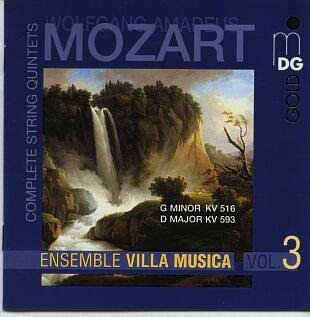 Composer: Wolfgang Amadeus Mozart
Composer: Wolfgang Amadeus Mozart
Works: String Quintet in G minor, K516; String Quintet in D major, K593
Performers: Ensemble Villa Musica
Recording: 6-7 February 2001 at the Fürstliche Reitbahn Bad Arolsen
Label: MD&G 304 1106-2
Mozart’s string quintets occupy a unique sphere within the classical canon, bridging the intimate expression of chamber music with the complexity of symphonic thought. The works presented in this volume, particularly the G minor Quintet (K516) and the D major Quintet (K593), encapsulate the emotional breadth and innovative spirit of Mozart’s late style. Composed during a period marked by personal turmoil and artistic maturity, these quintets reflect a profound engagement with themes of struggle, beauty, and ultimately, resolution.
Ensemble Villa Musica’s interpretation of K516 begins with an intriguing decision to adopt brisk tempos that lend an almost breathless urgency to the music. This choice, while initially disconcerting, reveals a deliberate effort to allow the composer’s voice to resonate without undue embellishment. The opening Allegro is marked by a tension that, rather than being resolved through traditional phrasing and dynamic contrast, is maintained in a manner that underscores the quintet’s restlessness. The second movement, marked Adagio, is undeniably beautiful, yet the ensemble’s choice to keep the emotional temperature contained invites listeners to explore the nuances of Mozart’s tragic contemplation. This interpretation challenges the listener to engage deeply with the music’s inherent complexities, particularly in the third movement’s major key finale, which has historically evoked debate regarding its optimistic façade.
The D major quintet (K593), composed just a few years later, presents a contrasting musical landscape. The sound-world here is notably brighter, and the ensemble’s approach facilitates a more overtly lyrical dialogue among the players. The playful nature of the rondo finale, with its falling semitones, showcases a delightful Haydn-esque humor that stands in stark relief to the yearning chromaticism of K516. The musicians’ ability to navigate these contrasting moods while maintaining clarity and cohesion is commendable, demonstrating their technical prowess and deep understanding of Mozart’s intentions.
Recording quality plays a significant role in shaping the listening experience, and the engineering captured during the sessions in Bad Arolsen is commendable. The balance between the instruments allows for a clear interplay of voices, particularly in the more intricate passages where counterpoint is prominent. Each instrumentalist’s contribution is distinct yet seamlessly integrated into the overall texture. However, while the clarity is impressive, one may long for a bit more warmth in the sound, which could have enhanced the emotional weight of K516’s more introspective moments.
When considering other recordings, the Villa Musica ensemble’s interpretation of K516 may not be the most immediately engaging. Comparisons with the likes of Grumiaux or the Lindsays reveal performances that are more involved and, consequently, more gripping. Yet, it is essential to recognize that the Villa Musica’s restrained approach can, paradoxically, facilitate a deeper exploration of the music’s emotional landscape. The juxtaposition of K516’s complexity with K593’s charm provides a well-rounded listening experience that captures the essence of Mozart’s late quintets.
This recording, with its combination of technical finesse and thoughtful interpretation, serves as an enriching addition to the discography of Mozart’s string quintets. Ensemble Villa Musica successfully invites listeners into a reflective engagement with these masterpieces, making the disc a worthy investment for both connoisseurs and casual listeners alike.



